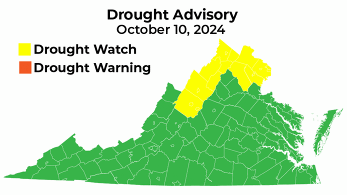
Due to recent precipitation from Hurricane Helene, the Virginia Department of Environmental Quality (DEQ), in coordination with the Virginia Drought Monitoring Task Force, has lifted drought advisories for 17 localities in Virginia. The drought warning for the Shenandoah region has been downgraded to a watch status and a drought watch advisory still exists in the Northern Virginia region.
Drought watch advisories have been lifted for the following regions:
- Big Sandy: Buchanan, Dickenson, Lee, Russell, Scott, Smyth, Tazewell, Washington, and Wise counties
- New River: Bland, Carroll, Floyd, Giles, Grayson, Montgomery, Pulaski, and Wythe counties
A drought watch advisory is intended to help Virginians prepare for a potential drought and is in effect for the Northern Virginia (Arlington, Fairfax, Fauquier, Loudoun, and Prince William counties) and Shenandoah (Augusta, Rockingham, Shenandoah, Frederick, Page, Warren, and Clarke counties) regions.
Several factors have contributed to the lifting and downgrading of advisories as well as the maintenance of drought watch advisories in the affected regions. Widespread and heavy precipitation over the past 30 days, notably from Tropical Storm Helene, has led to marked improvements in soil moisture and streamflow across Virginia. Stream flows have returned to normal levels throughout the Commonwealth with all stream gages within the monitoring network currently indicating normal status. Groundwater levels for monitoring wells in the Climate Response Network largely remain below normal and require additional precipitation events to recover over the short and long-term period. While recent precipitation events have resulted in improvements compared to the past 30-day period, groundwater levels in eight evaluation regions remain currently below the 25th percentile with two regions recording below the 5th percentile (Shenandoah and York James). Storage at major water supply reservoirs have improved slightly over the past two weeks and remain within normal ranges.
DEQ is working with local governments, public water works, and water users in the affected areas to ensure that conservation and drought response plans and ordinances are followed. Localities and Virginians that are supplied water from the Potomac River should consult the for specific triggers and actions to be taken. All Virginians are encouraged to protect water supplies by minimizing water use, monitoring drought conditions, and detecting and repairing leaks.
See the current drought status on the DEQ website.
###
|